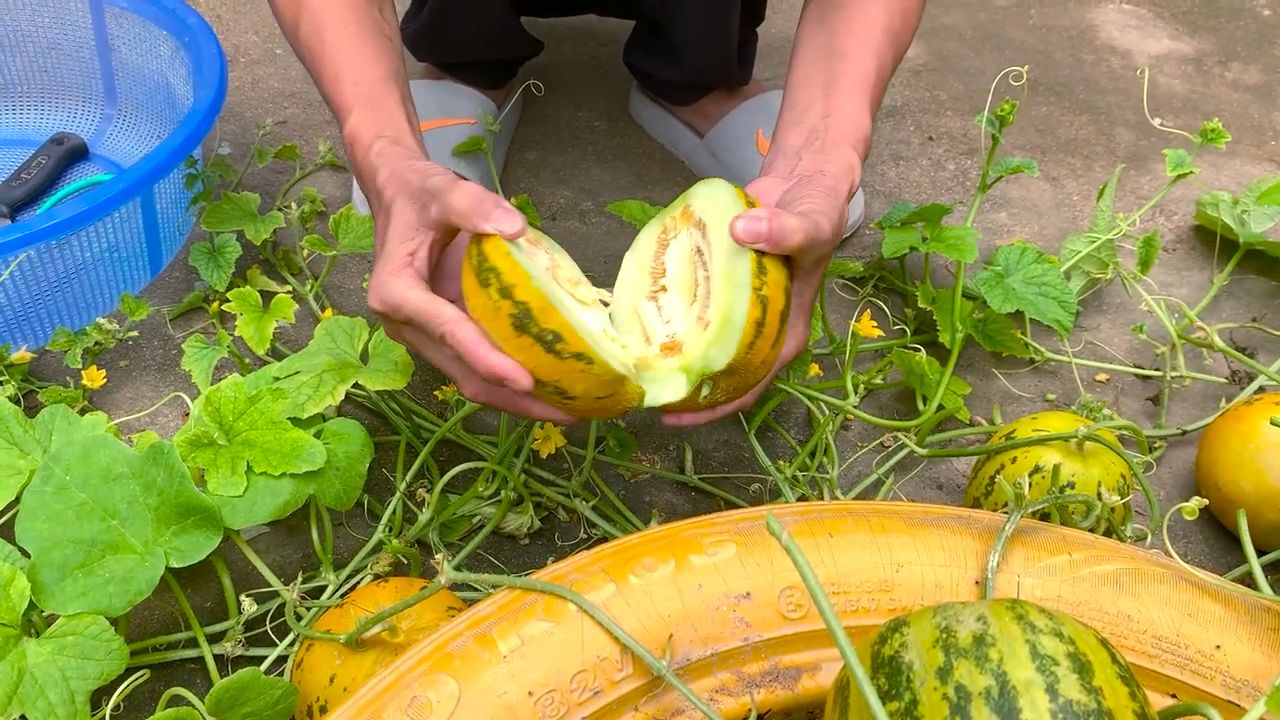Sweet Melon Growing Tips are what you need to unlock a summer filled with juicy, homegrown goodness! Imagine biting into a perfectly ripe, incredibly sweet melon that you nurtured from a tiny seed. Sounds dreamy, right? Well, it’s absolutely achievable, even if you don’t have acres of farmland. For centuries, cultures around the globe, from ancient Egypt to the Far East, have prized melons for their refreshing taste and nutritional benefits, carefully cultivating them using techniques passed down through generations.
But let’s be honest, sometimes the thought of growing your own food can feel a little intimidating. That’s where these DIY tricks and hacks come in! I’m here to share simple, effective methods that will help you master sweet melon growing tips, regardless of your experience level. Whether you’re dealing with limited space, tricky soil, or just want to maximize your yield, these tips will empower you to create a thriving melon patch right in your own backyard. Forget those bland, store-bought melons – get ready to savor the unparalleled flavor of homegrown sweetness!

Growing Sweet Melons: A DIY Guide to Juicy Success
Okay, melon lovers, let’s get down to business! Growing your own sweet melons can seem intimidating, but trust me, with a little know-how and some patience, you can be biting into a homegrown, juicy slice of heaven. I’m going to walk you through everything you need to know, from choosing the right variety to harvesting that perfect melon.
Choosing Your Melon Variety
First things first, you need to decide what kind of melon you want to grow. There are so many delicious options! Here’s a quick rundown to help you choose:
* Cantaloupe: A classic choice! They’re known for their orange flesh and netted rind. Look for varieties like ‘Athena’, ‘Hales Best’, or ‘Ambrosia’. They are relatively easy to grow and offer a reliable sweetness.
* Honeydew: These melons have smooth, pale green skin and sweet, light green flesh. ‘Honeycrisp’ and ‘Temptation’ are popular choices. They tend to need a longer growing season than cantaloupe.
* Watermelon: The quintessential summer fruit! From the classic ‘Crimson Sweet’ to the personal-sized ‘Sugar Baby’, there’s a watermelon for every garden. Watermelons need plenty of space and sunshine.
* Specialty Melons: Don’t be afraid to experiment! Consider trying Galia melons (sweet and aromatic), Charentais melons (French heirloom with intense flavor), or even Asian melons like Korean melons (crisp and refreshing).
Things to consider when choosing:
* Your climate: Some melons need a longer, hotter growing season than others. Check the days to maturity for each variety and compare it to your local climate.
* Available space: Watermelons, in particular, need a lot of room to sprawl. If you have a small garden, consider growing a bush variety or using a trellis.
* Personal preference: Ultimately, choose the melons you love to eat!
Preparing Your Garden Bed
Melons are hungry plants, so preparing your garden bed is crucial for success. They need well-drained soil that’s rich in organic matter.
* Sunlight: Melons need at least 6-8 hours of direct sunlight per day. Choose a location that gets plenty of sun.
* Soil: Melons prefer slightly acidic soil with a pH between 6.0 and 6.8. Amend your soil with compost or well-rotted manure to improve drainage and fertility.
* Drainage: Poor drainage can lead to root rot, so make sure your soil drains well. If you have heavy clay soil, consider building raised beds.
* Fertilizer: Incorporate a slow-release fertilizer into the soil before planting. Look for a fertilizer that’s high in phosphorus and potassium, which are essential for fruit development.
Starting Your Melon Seeds
You can either direct sow melon seeds in your garden or start them indoors. Starting indoors gives you a head start, especially in cooler climates.
* When to start: Start seeds indoors about 4-6 weeks before the last expected frost.
* What you’ll need: Seed starting trays or pots, seed starting mix, a heat mat (optional), and a grow light (optional).
* Sowing the seeds: Plant seeds about 1/2 inch deep in the seed starting mix. Keep the soil moist but not soggy.
* Germination: Melon seeds germinate best at temperatures between 70-80°F (21-27°C). Use a heat mat to speed up germination.
* Light: Once the seedlings emerge, provide them with plenty of light. A grow light is ideal, but a sunny windowsill can also work.
* Hardening off: Before transplanting your seedlings outdoors, you need to harden them off. This means gradually exposing them to outdoor conditions over a period of 7-10 days. Start by placing them in a sheltered spot for a few hours each day, gradually increasing the amount of time they spend outdoors.
Transplanting Your Melon Seedlings
Once the danger of frost has passed and the soil has warmed up, it’s time to transplant your melon seedlings into the garden.
* Timing: Transplant on a cloudy day or in the late afternoon to minimize stress on the seedlings.
* Spacing: Space cantaloupe and honeydew plants about 2-3 feet apart. Watermelons need more space, about 3-4 feet apart.
* Planting: Dig a hole that’s slightly larger than the root ball of the seedling. Gently remove the seedling from its pot and place it in the hole. Backfill with soil and water thoroughly.
* Mulching: Apply a layer of mulch around the plants to help retain moisture, suppress weeds, and regulate soil temperature. Straw, hay, or wood chips are good choices.
Caring for Your Melon Plants
Now that your melon plants are in the ground, it’s time to provide them with the care they need to thrive.
* Watering: Melons need consistent watering, especially during fruit development. Water deeply and regularly, aiming for about 1-2 inches of water per week. Avoid overhead watering, which can lead to fungal diseases. Drip irrigation is ideal.
* Fertilizing: Side-dress your melon plants with a balanced fertilizer every 2-3 weeks. You can also use a liquid fertilizer, such as fish emulsion or seaweed extract.
* Weeding: Keep your garden bed free of weeds, which can compete with your melon plants for nutrients and water.
* Pest control: Keep an eye out for common melon pests, such as aphids, squash bugs, and cucumber beetles. Use organic pest control methods, such as insecticidal soap or neem oil, to control these pests.
* Pollination: Melons need to be pollinated in order to produce fruit. If you’re not seeing any fruit set, you may need to hand-pollinate the flowers. To hand-pollinate, use a small paintbrush to transfer pollen from the male flowers to the female flowers. Female flowers have a small fruit at the base of the flower.
* Pruning (Optional): Some gardeners prune their melon plants to encourage fruit production. You can prune off any suckers (small shoots that grow from the base of the plant) or any leaves that are shading the fruit.
Protecting Your Melons
As your melons start to develop, you may need to protect them from pests and diseases.
* Pest Protection:
* Row covers: Use row covers to protect young plants from pests like cucumber beetles. Remove the row covers when the plants start to flower to allow for pollination.
* Squash vine borers: These pests can be devastating to melon plants. Look for signs of infestation, such as wilting vines and holes in the stems. You can try to remove the borers by hand or use a biological control like Bacillus thuringiensis (Bt).
* Fruit flies: As your melons ripen, they may attract fruit flies. Use fruit fly traps to control these pests.
* Disease Prevention:
* Fungal diseases: Melons are susceptible to fungal diseases like powdery mildew and downy mildew. To prevent these diseases, provide good air circulation, avoid overhead watering, and apply a fungicide if necessary.
* Crop rotation: Rotate your crops each year to prevent soilborne diseases from building up.
Harvesting Your Melons
Knowing when to harvest your melons is key to enjoying their full flavor and sweetness. Each type of melon has its own indicators of ripeness.
* Cantaloupe:
* Aroma: A ripe cantaloupe will have a sweet, musky aroma.
* Stem slip: The stem should easily slip away from the fruit with a gentle tug.
* Color: The rind should turn from green to a tan or yellowish color.
* Sound: A ripe cantaloupe will sound hollow when you tap it.
* Honeydew:
* Aroma: A ripe honeydew will have a slightly sweet aroma.
* Blossom end: The blossom end (the end opposite the stem) should be slightly soft and yielding to pressure.
* Color: The rind should turn from green to a creamy white color.
* Watermelon:
* Tendril: The tendril closest to the melon should be brown and dry.
* Ground spot: The ground spot (the spot where the melon rests on the ground) should be yellow or cream-colored.
* Sound: A ripe watermelon will sound dull and hollow when you thump it.
* General Tips:
* Harvest in the morning: Harvest your melons in the morning, when they’re at their coolest.
* Use
Conclusion
So, there you have it! Mastering these simple yet effective sweet melon growing tips can truly transform your gardening experience and reward you with the most delectable, homegrown melons imaginable. We’ve covered everything from selecting the right varieties and preparing your soil to providing optimal sunlight and water, and even tackling common pests and diseases. But the real magic lies in putting these tips into practice and observing the unique needs of your own melon patch.
Why is this a must-try? Because store-bought melons simply can’t compare to the flavor and satisfaction of harvesting your own perfectly ripe, juicy sweet melon. Imagine biting into a melon bursting with sweetness, knowing that you nurtured it from seed to table. Plus, you’ll have complete control over the growing process, ensuring that your melons are free from harmful chemicals and pesticides. It’s a healthier, tastier, and more rewarding experience all around.
Don’t be afraid to experiment! Try different melon varieties to discover your personal favorites. Consider using companion planting techniques to deter pests and attract beneficial insects. You could even explore vertical gardening methods to maximize space in smaller gardens. For example, cantaloupes and smaller watermelons can be trained to grow up trellises, saving valuable ground space. Another variation is to try succession planting, staggering your planting dates to enjoy a continuous harvest of sweet melons throughout the summer. If you live in a cooler climate, consider starting your melon seeds indoors to give them a head start.
We’re confident that with these sweet melon growing tips, you’ll be well on your way to enjoying a bountiful harvest. But the best way to learn is by doing. So, grab your seeds, prepare your soil, and get ready to embark on a delicious gardening adventure.
We’d love to hear about your experiences! Share your successes, challenges, and any unique tips you discover along the way in the comments below. Let’s create a community of melon-loving gardeners who can learn from each other and celebrate the joys of homegrown sweetness. Happy growing!
Frequently Asked Questions (FAQ)
What are the best melon varieties to grow for beginners?
For beginners, we recommend starting with easier-to-grow varieties like cantaloupe (specifically, ‘Athena’ or ‘Hales Best Jumbo’) and smaller watermelon varieties such as ‘Sugar Baby’ or ‘Bush Sugar Baby’. These varieties are relatively disease-resistant and don’t require as much space as some of the larger watermelon types. Honeydew melons can also be a good choice, but they may require a slightly longer growing season. Look for varieties that are specifically recommended for your region and climate. Local nurseries and garden centers are excellent resources for finding the best options for your area.
How much sunlight do sweet melons need?
Sweet melons are sun-worshippers! They need at least 6-8 hours of direct sunlight per day to thrive. Without sufficient sunlight, the fruits will be smaller, less sweet, and more susceptible to diseases. Choose a planting location that receives full sun throughout the day. If you live in a particularly hot climate, some afternoon shade may be beneficial to prevent the plants from overheating.
How often should I water my melon plants?
Watering is crucial for healthy melon growth. Water deeply and regularly, especially during hot, dry periods. Aim to keep the soil consistently moist, but not waterlogged. Overwatering can lead to root rot and other fungal diseases. A good rule of thumb is to water deeply once or twice a week, depending on the weather conditions. Use a soaker hose or drip irrigation to deliver water directly to the roots, avoiding wetting the foliage, which can encourage disease. As the melons begin to ripen, you can reduce watering slightly to concentrate the sugars and enhance their sweetness.
What kind of soil is best for growing sweet melons?
Sweet melons prefer well-drained, fertile soil that is rich in organic matter. Before planting, amend your soil with compost, aged manure, or other organic amendments to improve its drainage, fertility, and water-holding capacity. Melons also prefer a slightly acidic to neutral soil pH (around 6.0 to 7.0). You can test your soil pH with a home testing kit or by sending a sample to your local agricultural extension office. If your soil is too acidic, you can add lime to raise the pH. If it’s too alkaline, you can add sulfur to lower the pH.
How do I know when my sweet melons are ripe?
Knowing when to harvest your melons is key to enjoying their peak flavor. Here are some general guidelines:
* **Cantaloupe:** Look for a change in color from green to tan or yellow. The stem should easily slip from the vine with a gentle tug. The melon should also have a fragrant aroma.
* **Watermelon:** Thump the melon. A ripe watermelon will have a deep, hollow sound. The tendril closest to the melon should be brown and dry. The underside of the melon (where it rests on the ground) should be yellow or creamy.
* **Honeydew:** Look for a creamy yellow color and a slightly waxy feel. The blossom end should be slightly soft and give to gentle pressure.
Remember that these are just general guidelines, and the specific characteristics of ripeness may vary slightly depending on the variety.
What are some common pests and diseases that affect sweet melons, and how can I prevent them?
Common pests that attack sweet melons include aphids, squash bugs, cucumber beetles, and vine borers. Common diseases include powdery mildew, fusarium wilt, and anthracnose. To prevent these problems, practice good garden hygiene, such as removing plant debris and weeds regularly. Use row covers to protect young plants from pests. Encourage beneficial insects, such as ladybugs and lacewings, which prey on aphids and other pests. Choose disease-resistant varieties whenever possible. If you do encounter pests or diseases, treat them promptly with appropriate organic or chemical controls. Crop rotation can also help to prevent soilborne diseases.
Can I grow sweet melons in containers?
Yes, you can grow sweet melons in containers, but you’ll need to choose smaller varieties and provide them with adequate support. Use a large container (at least 20 gallons) with good drainage. Fill the container with a high-quality potting mix. Provide a trellis or other support for the vines to climb. Water and fertilize regularly. Be sure to choose a sunny location for your container garden.
How can I improve the sweetness of my melons?
Several factors can influence the sweetness of your melons. Make sure they receive plenty of sunlight and water. Avoid over-fertilizing with nitrogen, which can promote leafy growth at the expense of fruit production. Reduce watering slightly as the melons begin to ripen to concentrate the sugars. Also, ensure that the soil is rich in potassium, which is essential for fruit development and sweetness. You can add potassium-rich fertilizers, such as potassium sulfate, to your soil.
What is companion planting, and how can it benefit my sweet melon crop?
Companion planting involves growing different plants together to benefit each other. Some good companion plants for sweet melons include:
* **Marigolds:** Repel nematodes and other pests.
* **Nasturtiums:** Attract aphids away from melon plants.
* **Radishes:** Deter cucumber beetles.
* **Beans:** Fix nitrogen in the soil, which can benefit melon growth.
* **Oregano:** Acts as a general pest repellent.
Avoid planting melons near potatoes, as they can compete for nutrients.
How do I save seeds from my sweet melons for next year?
Saving seeds from your sweet melons is a great way to propagate your favorite varieties. Choose a fully ripe melon from a healthy plant. Scoop out the seeds and rinse them thoroughly to remove any pulp. Spread the seeds out on a paper towel to dry completely. Once the seeds are dry, store them in an airtight container in a cool, dark, and dry place. Properly stored melon seeds can remain viable for several years. Keep in mind that hybrid varieties may not produce true-to-type offspring, so you’ll get the most consistent results by saving seeds from heirloom or open-pollinated varieties.




Leave a Comment